Nine Ways Private Owners Are Coerced By Unions Into Requiring Project Labor Agreements
Sometimes, private owners of energy projects, banks, retail stores, manufacturing facilities, hotels, casinos and hospitals require contractors to agree to a project labor agreement (PLA) favoring trade unions as a condition of winning a construction contract funded by private money. This is known as a private PLA mandate or a private owner-mandated PLA.
A private PLA mandate should not be confused with a PLA voluntarily executed by a contractor with various construction labor unions, a non-controversial practice permitted by the National Labor Relations Act that does not end open, fair and competitive bidding for construction contracts.
In an effort to convince lawmakers to require PLAs on taxpayer-funded projects (known as government-mandated PLAs), PLA proponents make fallacious claims about the use of PLAs in the private sector.
Proponents of these union-favoring schemes site a handful of well-known private PLA projects and argue that since PLA mandates are “widespread” in the private sector, government should follow the private sector’s lead and require PLAs on more taxpayer-funded projects.
As TheTruthAboutPLAs.com exposed April 22, PLAs in the private sector actually are not “widespread,” as only a small fraction of public and private construction put in place in 2010 and 2011 was built with a PLA (unverifiable data supplied by PLA advocates suggests 4 percent to 6 percent of all construction put in place is covered by PLAs).
And of the private projects subject to PLA mandates, private owners often require PLAs because they are coerced into doing so by construction trade unions.
Owners complain there is little they can do but agree to require a PLA to avoid expensive, time-consuming and frustrating union-organized corporate campaigns that harm their brand, employees and shareholders. George Washington University Professor Jarol B. Manheim’s 2006 study highlights notable union corporate campaign tactics used by Big Labor for decades to extract results from owners favorable to the union agenda.
Following are nine ways private owners are coerced into mandating PLAs on private projects:
1. Threat of Union Strikes
Unions market PLAs to public and private owners as a tool to prevent strikes and labor unrest caused exclusively by union members. Strikes can delay projects, resulting in lost sales, oversupply of seasonal merchandise and longer construction schedules, which all increase owner costs. Time means money to private owners and PLAs are seen by many owners as an insurance policy–a necessary evil of sorts–to prevent union-led strikes on mixed and union-only jobsites.
In 2009, Big Labor’s public relations consultants advised union bosses to rebrand PLAs as Community Workforce Agreements (CWAs) because the public wasn’t comfortable with the implicit threats at the heart of PLAs. In short, they weren’t buying the concept of unions being rewarded with a labor monopoly on a project (a PLA) for preventing a problem created by labor unions (strikes and labor unrest). PLAs felt too much like blackmail, so spin doctors pushed unions to focus on the alleged benefits a PLA could deliver to a community, even though these benefits can be easily achieved without PLAs.
Don’t be fooled: This slick marketing is simply putting lipstick on the PLA pig.
PLAs have failed to prevent strikes on a number of high-profile private projects, such as the construction of the $850 million Trump International Hotel and Tower in downtown Chicago, just as they have failed to prevent strikes on publicly financed projects.
2. Bad Publicity
Some private owners fear bad publicity from construction unions threatening to picket, boycott, handbill or harass owners with inflatable rats and deploy other tactics if they don’t agree to a PLA or an all-union workforce.
Owners often require PLAs to prevent union behavior that could drive away customers or hurt brands. Check out www.ShameOnUnionBanners.com for examples of such tactics.
However, disruptive tactics can backfire on unions, as evidenced by this local news investigation video and this clever counter-bannering effort from a car dealership:
3. Project Approval/Political Considerations
In many localities, private owners need the approval of lawmakers to get rights and permits to build a project. If Big Labor-favoring lawmakers control project approval, developers often sign PLAs to mollify lawmakers and enlist union lobbyists to get the project approved by voters and lawmakers. For example, review the recently approved casino in Prince George’s County, Md., Wal-Mart projects in Chicago and TransCanada’s Keystone XL Pipeline.
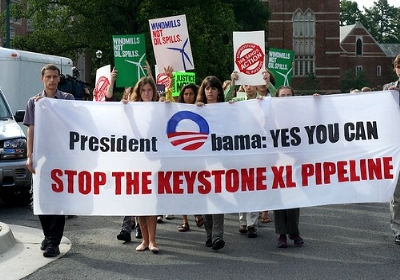
4. Tax Breaks and Corporate Welfare
While still technically a private project because it is not procured by a government entity, some owners agree to PLAs in order to receive tax breaks or other forms of corporate welfare when looking to relocate corporate headquarters or build new manufacturing facilities that will bring jobs to a region. Union-friendly lawmakers cut these backroom deals to ensure union supporters benefit from this transaction. In return, union-friendly lawmakers receive campaign contributions and grassroots support from construction unions. It is similar to the well-rehearsed cycle of corruption perfected with government-mandated PLAs.
5. Interference with Unionized Employees
Some casinos, hospitals, hotels retailers and manufacturers in the private sector employing a unionized workforce fear a dispute with construction trade unions will interfere with daily operations. To owners, paying a PLA cost premium to avoid a construction union-led strike during a project renovation offsets increased ong-term costs associated with any labor-related interference of their business’ daily operations. In addition, owners sign PLAs with construction unions when faced with corporate campaigns seeking to unionize service-related employees. Owners divide the labor movement by pitting unions opposed to the project (as long as service workers are not unionized – a favorite tactic of SEIU) versus construction unions in favor of the project because of the union jobs created by the PLA.
6. Monetary Pressure
Banks, pharmacies and insurance companies building headquarters or small-end retail facilities often are targeted for PLAs because of their relationship with labor’s institutional bank accounts, pension funds, medical and other benefit plans. If these service providers don’t build with a union-only PLA, unions threaten to take their business to another competitor who will build all-union and they will create public problems for their brand.
7. Greenmail
In California, astroturf environmental groups created and bankrolled by construction trade unions “greenmail” private developers of solar and other energy projects into mandating a PLA on contractors. Unions “greenmail” developers by exploiting the California Environmental Quality Act, which allows third parties to obstruct and indefinitely delay approval of construction projects by filing thousands of pages worth of frivolous environmental objections. Time and again, once developers agree to require a PLA, the phony environmental objections vanish. It’s no accident that almost every new energy project in California since 2000 has been built with a PLA required by private owners.
California lawmakers are taking steps to prevent greenmail abuse, but efforts are being hijacked by Big Labor lobbyists and PLA advocates controlling California legislature’s Democrat majority. Real reform is unlikely.
8. Labor Concessions for Union-Controlled Urban Real Estate Deals
In areas with high union market share such as New York City, unions pimp PLAs to private owners to achieve concessions to archaic union work rules and the greater-than free market wage and benefit rates required by union collective bargaining agreements. As explained in this recent article, without these concessions, union market share would continue to erode. Excessive labor rates mothball projects by making financing impossible. Or union-friendly developers lose development deals to nonunion competitors because nonunion teams have lower construction costs and can afford to outbid union-friendly developers.
However, a 2011 report found New York developers have been “universally disappointed” by the promised cost savings from PLAs on recent New York real estate projects, calling into question the effectiveness of this strategy. While it isn’t particularly coercive, developers should be wary that promised cost savings resulting from PLAs are often illusory, especially if the developer mandates a PLA instead of using a competitive bidding process.
9. Union-Backed Financing
Union-backed financing instruments, such as the AFL-CIO’s Housing Investment Trust, invest union pensions and other assets into private projects in exchange for a promise by developers to build the project union-only. See projects such as the proposed Las Vegas City Hall, the disastrous Westin Diplomat Hotel in Hollywood, Fla., Potrero Launch apartment project in San Francisco and the Carpenter’s Tower in Washington. An investment of a few million dollars of union pension funds can jump start a project and steer tens of millions of dollars worth of contracts to unionized contractors and create jobs exclusively for union members without real competition from merit shop firms.

A Coercion-Free Choice
Finally, some owners make a coercion-free choice to build a private project with a PLA or an all-union workforce for legitimate reasons. In these instances, unionized contractors and unions operating under a PLA offer a product that appeals to a specific owners’ needs.
While it is disappointing a private owner would choose to engage in discrimination against 86 percent of the U.S. construction workforce and discourage competition from otherwise qualified contractors and skilled employees by requiring a PLA, it is their prerogative in a free market to do what they want with their money (like spend an extra 12 percent to 18 percent).
Shame on competitors for failing to educate private owners about their product and/or failing to meet the needs of customers and the market.
TheTruthAboutPLAs.com recognizes the right of private owners to require PLAs as long as it is a choice made free from coercive tactics of PLA advocates.
The Bottom Line
Private projects and taxpayer-funded projects are subject to a different set of rules. Taxpayer-funded projects must comply with competitive bidding statutes supporting fair and open competition and other regulations and standards ensuring taxpayers get the best possible product at the best possible price. In short, government-mandated PLAs restrict competition, increase costs, and needlessly discriminate against experienced competitors and their employees. If private owners want to experience these headaches, they are free to do so on their own dime.
If you have documented other coercive tactics used by PLA proponents to secure private sector PLAs in your market, let us know by leaving a note in the comments section.












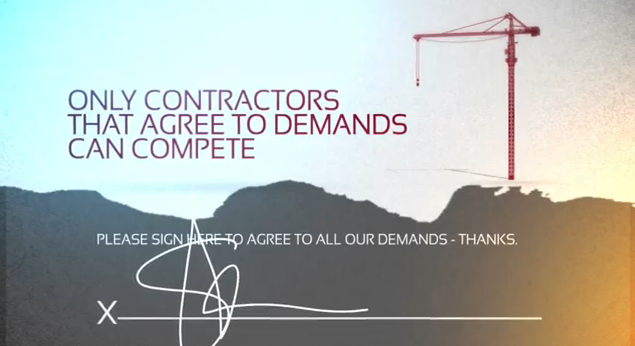
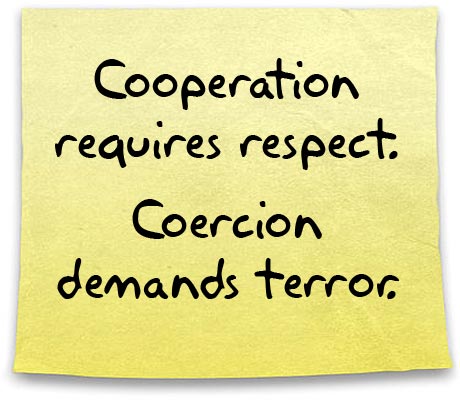



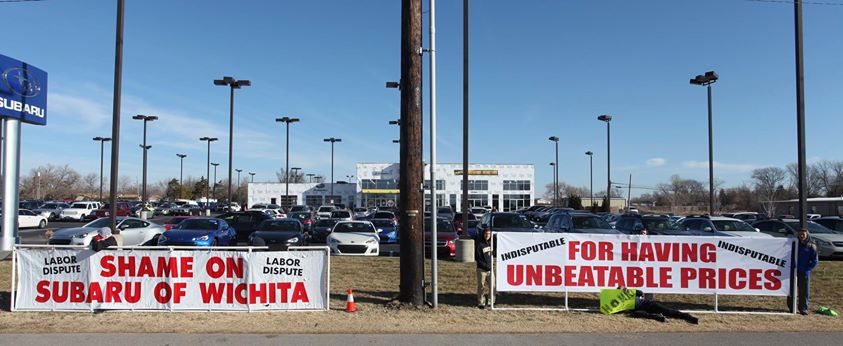

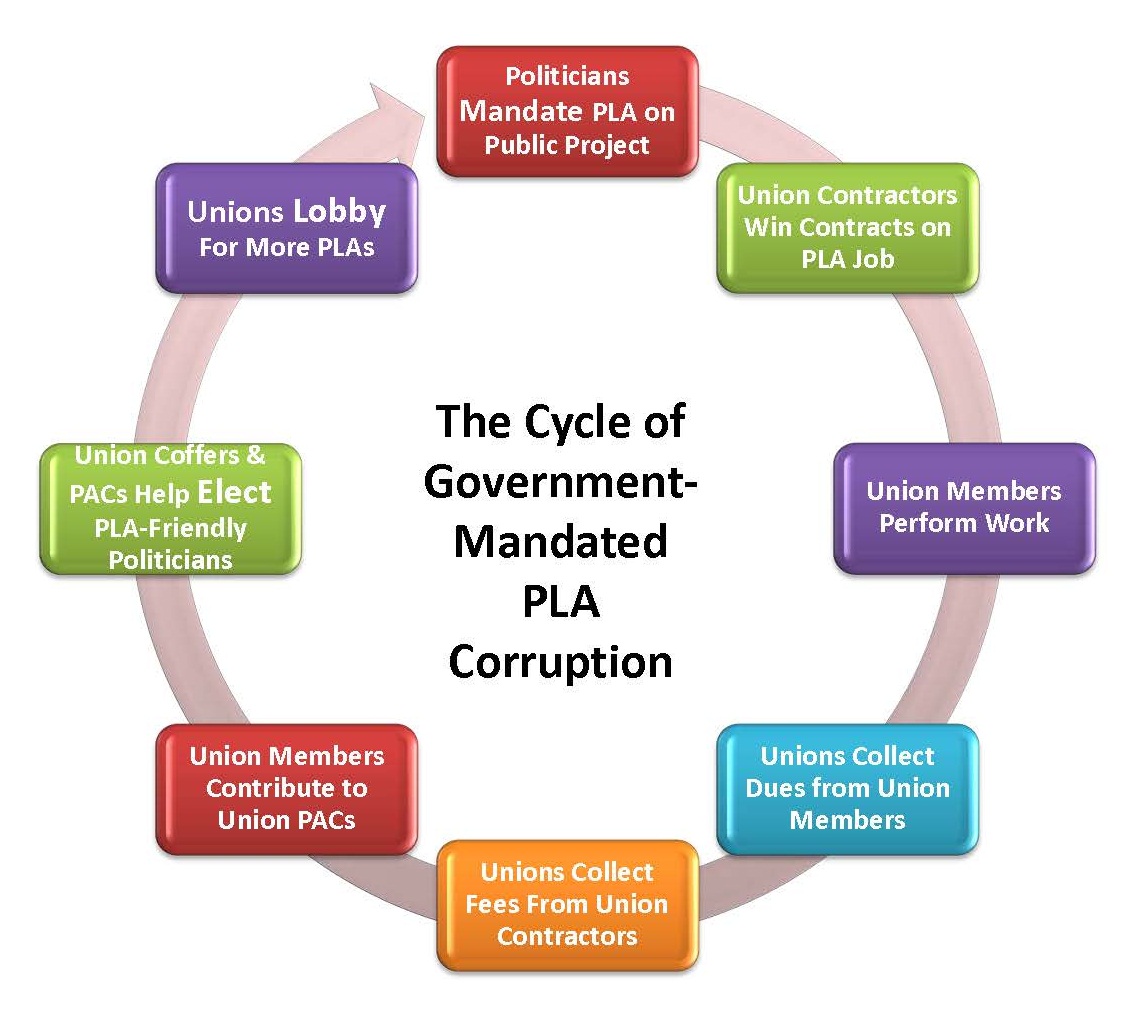


2 Responses to Nine Ways Private Owners Are Coerced By Unions Into Requiring Project Labor Agreements
[…] Nine Ways Private Owners Are Coerced By Unions Into Requiring Project Labor Agreements May 6, 2013, The Truth About PLA’s Sometimes, private owners of energy projects, banks, retail stores, manufacturing facilities, hotels, casinos and hospitals require contractors to agree to a project labor agreement (PLA) favoring trade unions as a condition of winning a construction contract funded by private money. This is known as a private PLA mandate or a private owner-mandated PLA. A private PLA mandate should not be confused with a PLA voluntarily executed by a contractor with various construction labor unions, a non-controversial practice permitted by the National Labor Relations Act that does not end open, fair and competitive bidding for construction contracts. In an effort to convince lawmakers to require PLAs on taxpayer-funded projects (known as government-mandated PLAs), PLA proponents make fallacious claims about the use of PLAs in the private sector. Proponents of these union-favoring schemes site a handful of well-known private PLA projects and argue that since PLA mandates are “widespread” in the private sector, government should follow the private sector’s lead and require PLAs on more taxpayer-funded projects. (read article) […]
[…] Nine Ways Private Owners Are Coerced By Unions Into Requiring Project Labor Agreements May 6, 2013, The Truth About PLA’s Sometimes, private owners of energy projects, banks, retail stores, manufacturing facilities, hotels, casinos and hospitals require contractors to agree to a project labor agreement (PLA) favoring trade unions as a condition of winning a construction contract funded by private money. This is known as a private PLA mandate or a private owner-mandated PLA. A private PLA mandate should not be confused with a PLA voluntarily executed by a contractor with various construction labor unions, a non-controversial practice permitted by the National Labor Relations Act that does not end open, fair and competitive bidding for construction contracts. In an effort to convince lawmakers to require PLAs on taxpayer-funded projects (known as government-mandated PLAs), PLA proponents make fallacious claims about the use of PLAs in the private sector. Proponents of these union-favoring schemes site a handful of well-known private PLA projects and argue that since PLA mandates are “widespread” in the private sector, government should follow the private sector’s lead and require PLAs on more taxpayer-funded projects. (read article) […]